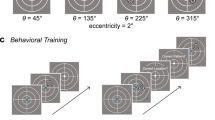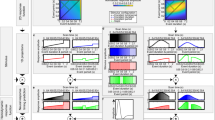Abstract
When monkeys perform a delayed match-to-sample task, some neurons in the anterior inferotemporal cortex show sustained activity following the presentation of specific visual stimuli, typically only those that are shown repeatedly. When sample stimuli are shown in a fixed temporal order, the few images that evoke delay activity in a given neuron are often neighboring stimuli in the sequence, suggesting that this delay activity may be the neural correlate of associative long-term memory. Here we report that stimulus-selective sustained activity is also evident following the presentation of the test stimulus in the same task. We use a neural network model to demonstrate that persistent stimulus-selective activity across the intertrial interval can lead to similar mnemonic representations (distributions of delay activity across the neural population) for neighboring visual stimuli. Thus, inferotemporal cortex may contain neural machinery for generating long-term stimulus–stimulus associations.
This is a preview of subscription content, access via your institution
Access options
Subscribe to this journal
Receive 12 print issues and online access
$209.00 per year
only $17.42 per issue
Buy this article
- Purchase on Springer Link
- Instant access to full article PDF
Prices may be subject to local taxes which are calculated during checkout





Similar content being viewed by others
References
Miyashita, Y. Neuronal correlate of visual associative long-term memory in the primate temporal cortex. Nature 335, 817–820 ( 1988).
Fuster, J. M. & Jervey, J. P. Inferotemporal neurons distinguish and retain behaviorally relevant features of visual stimuli. Science 212, 952–955 ( 1981).
Sakai, K. & Miyashita, Y. Neural organization for the long-term memory of paired associates. Nature 354, 152–155 (1991).
Nakamura, K. & Kubota, K. Mnemonic firing of neurons in the monkey temporal pole during a visual recognition memory task. J. Neurophysiol. 74, 162–178 (1995).
Wilson, F. A., Scalaidhe, S. P. & Goldman-Rakic, P. S. Dissociation of object and spatial processing domains in primate prefrontal cortex. Science 260, 1955–1958 (1993).
Rao, S. C., Rainer, G. & Miller, E. K. Integration of what and where in the primate prefrontal cortex. Science 276, 821–824 ( 1997).
Amit, D. J., Brunel, N. & Tsodyks, M. V. Correlations of cortical hebbian reverberations: Theory versus experiment. J. Neurosci. 14, 6435 –6445 (1994).
Amit, D. J. The Hebbian paradigm reintegrated: Local reverberations as internal representations. Behav. Brain Sci. 18, 617–657 (1995).
Amit, D. J., Fusi, S. & Yakovlev, V. Paradigmatic working memory (attractor) cell in IT cortex. Neural Comput. 9, 1071–1093 ( 1997).
Miller, E. K., Li, L. & Desimone, R. Activity of neurons in anterior inferior temporal cortex during a short-term memory task. J. Neurosci. 13, 1460– 1478 (1993).
Brunel, N. Hebbian learning of context in recurrent neural networks. Neural Comput. 8, 1677–1710 (1996).
Amit, D. J. & Brunel, N. Global spontaneous activity and local structured (learned) delay activity in cortex. Cereb. Cortex 7, 237–252 (1997).
Griniasti, M., Tsodyks, M. V. & Amit, D. J. Conversion of temporal correlations between stimuli to spatial correlations between attractors. Neural Comput. 5, 1–9 (1993).
Scalaidhe, S. P. O., Wilson, F. A. & Goldman-Rakic, P. S. Areal segregation of face-processing neurons in prefrontal cortex. Science 278, 1135– 1138 (1997).
Fuster, J. M. Inferotemporal units in selective visual attention and short-term memory. J. Neurophysiol. 64, 681–697 ( 1990).
Miller, E. K., Erickson, C. & Desimone, R. Neural mechanisms of working memory in prefrontal cortex of the macaque. J. Neurosci. 16, 5154–5167 (1996).
Murray, E. A., Gaffan, D. & Mishkin, M. Neural substrates of visual stimulus-stimulus association in rhesus monkeys . J. Neurosci. 13, 4549– 4561 (1993).
Gutnikov, S. A., Yuan-Ye, M. & Gaffan, D. Temporo-frontal disconnection impairs visual-visual paired association learning but not configural learning in macaca monkeys . Eur. J. Neurosci. 9, 1524– 1529 (1997).
Tanaka, K. Inferotemporal cortex and object vision. Annu. Rev. Neurosci. 19, 109–140 (1996).
Wallis, G. & Rolls, E. T. Invariant face and object recognition in the visual system. Prog. Neurobiol. 51, 167–194 (1997).
Bartlett, M. & Sejnowski, T. Learning viewpoint invariant representations from visual experience using attractor networks. Network (in press).
DeRenzi, E., Faglioni, P. & Villa, P. Topographical amnesia. J. Neurol. Neurosurg. Psychiatry 40, 498–505 (1977).
Whiteley, A. M. & Warrington, E. K. Selective impairment of topographical memory: a single case study. J. Neurol. Neurosurg. Psychiatry 41, 575–578 (1978).
Landis, T. Cummings, J. L. Benson, D. F. & Palmer, E. P. Loss of topographic familiarity. Arch. Neurol. 43, 132– 136 (1986).
Maguire, E. A., Burke, T. Philips, J. & Staunton, H. Topographical disorientation following unilateral temporal lobe lesions in humans. Neuropsychologia 34, 994–1004 (1996).
Petersen, C. C. H., Malenka, R. C., Nicoll, R. A. & Hopfield, J. J. All-or-none potentiation at CA3-CA1 synapses. Proc. Natl. Acad. Sci. USA 95, 4732–4737 ( 1998).
Acknowledgements
We thank Gadi Goelman for technical support in the MRI testing, Michail Dvorkin for development of some of the data analysis tools and Nicolas Brunel for help in reproducing his simulations. Robert Shapley pointed out the possible relevance of the connection between prosopagnosia and navigation problems in patients with temporal-lobe lesions. Daniel Amit and Shaul Hochstein commented on earlier versions of the manuscript. This work was supported by grants from the Israel Academy of Science and Israel National Institute of Psychobiology (V.Y.) and a McDonnel-Pew grant for cognitive neuroscience (E.Z).
Author information
Authors and Affiliations
Corresponding author
Rights and permissions
About this article
Cite this article
Yakovlev, V., Fusi, S., Berman, E. et al. Inter-trial neuronal activity in inferior temporal cortex: a putative vehicle to generate long-term visual associations. Nat Neurosci 1, 310–317 (1998). https://doi.org/10.1038/1131
Received:
Accepted:
Issue Date:
DOI: https://doi.org/10.1038/1131
This article is cited by
-
Dynamic branching in a neural network model for probabilistic prediction of sequences
Journal of Computational Neuroscience (2022)
-
Rotational dynamics reduce interference between sensory and memory representations
Nature Neuroscience (2021)
-
Single Canonical Model of Reflexive Memory and Spatial Attention
Scientific Reports (2015)
-
Temporal context and conditional associative learning
BMC Neuroscience (2010)
-
Neural attractor dynamics in object recognition
Experimental Brain Research (2010)



